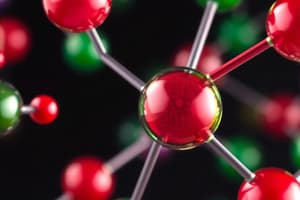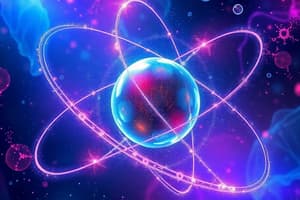Podcast
Questions and Answers
What does the First Law of Thermodynamics state?
What does the First Law of Thermodynamics state?
- Total entropy of a closed system can increase.
- Heat content in a system is independent of energy transformations.
- Energy can be created or destroyed under certain conditions.
- Energy can only be transformed, not created or destroyed. (correct)
Which statement about reaction rates is accurate?
Which statement about reaction rates is accurate?
- Reaction rates depend solely on the temperature of the environment.
- The reaction rate is the speed at which reactants are converted to products. (correct)
- Reaction rates can only be determined at equilibrium.
- All reactions occur at the same rate regardless of conditions.
What occurs during oxidation in redox reactions?
What occurs during oxidation in redox reactions?
- No change in the oxidation state occurs.
- Loss of electrons and an increase in oxidation state. (correct)
- Gain of electrons and a decrease in oxidation state.
- Equal transfer of electrons between two substances.
What characterizes a system at equilibrium?
What characterizes a system at equilibrium?
What is the purpose of titration in laboratory techniques?
What is the purpose of titration in laboratory techniques?
What defines an element uniquely?
What defines an element uniquely?
Which of the following describes a covalent bond?
Which of the following describes a covalent bond?
What is the pH range of neutral solutions?
What is the pH range of neutral solutions?
Which type of chemical reaction involves the breakdown of a compound into simpler substances?
Which type of chemical reaction involves the breakdown of a compound into simpler substances?
Which statement about ionic bonds is accurate?
Which statement about ionic bonds is accurate?
What is the primary purpose of stoichiometry in chemistry?
What is the primary purpose of stoichiometry in chemistry?
Which particle determines the atomic identity of an atom?
Which particle determines the atomic identity of an atom?
What do groups on the periodic table indicate?
What do groups on the periodic table indicate?
Study Notes
Basic Concepts
- Matter: Anything that has mass and occupies space; exists in solid, liquid, or gas states.
- Atoms: Basic units of matter; composed of protons, neutrons, and electrons.
- Elements: Pure substances that cannot be broken down; defined by their number of protons (atomic number).
- Compounds: Substances formed from two or more elements chemically bonded together.
Atomic Structure
- Protons: Positively charged particles in the nucleus; determines atomic identity.
- Neutrons: Neutral particles in the nucleus; contribute to atomic mass.
- Electrons: Negatively charged particles orbiting the nucleus; involved in chemical bonding.
- Atomic Mass: Sum of protons and neutrons in an atom's nucleus.
The Periodic Table
- Organized by increasing atomic number; shows relationships between elements.
- Groups: Vertical columns that indicate similar chemical properties.
- Periods: Horizontal rows that indicate energy levels of electrons.
Chemical Bonds
- Ionic Bonds: Formed when electrons are transferred from one atom to another, resulting in charged ions.
- Covalent Bonds: Formed when atoms share electrons.
- Metallic Bonds: Occur in metals where electrons are shared among a lattice of atoms.
Chemical Reactions
- Reactants: Substances that undergo a change during a reaction.
- Products: Substances formed as a result of a chemical reaction.
- Types of Reactions:
- Synthesis: Combining elements to form a compound.
- Decomposition: Breaking down a compound into simpler substances.
- Single Replacement: One element replaces another in a compound.
- Double Replacement: Exchange of partners between two compounds.
- Combustion: Reaction of a substance with oxygen, producing heat and light.
Stoichiometry
- Study of quantitative relationships in chemical reactions.
- Uses balanced chemical equations to calculate amounts of reactants and products.
Acids and Bases
- Acids: Substances that donate protons (H+ ions); can taste sour and turn blue litmus paper red.
- Bases: Substances that accept protons; can taste bitter and turn red litmus paper blue.
- pH Scale: Measures the acidity or alkalinity of a solution; ranges from 0 (acidic) to 14 (basic).
Organic Chemistry
- Study of carbon-containing compounds.
- Functional Groups: Specific groups of atoms that impart characteristic properties to molecules (e.g., hydroxyl, carboxyl, amino).
Thermodynamics
- First Law: Energy cannot be created or destroyed, only transformed.
- Second Law: Total entropy of a closed system can never decrease over time.
- Enthalpy (H): Measure of heat content in a system.
Kinetics and Equilibrium
- Reaction Rate: The speed at which reactants are converted into products.
- Equilibrium: State where the rates of forward and reverse reactions are equal; concentrations of reactants and products remain constant.
Redox Reactions
- Involve the transfer of electrons between substances.
- Oxidation: Loss of electrons; increase in oxidation state.
- Reduction: Gain of electrons; decrease in oxidation state.
Laboratory Techniques
- Filtration: Separating solids from liquids.
- Distillation: Separating liquids based on boiling points.
- Titration: Determining concentration of a solution by reacting it with a solution of known concentration.
Matter and Atomic Structure
- Matter exists in solid, liquid, and gaseous states, possessing mass and occupying space.
- Atoms are fundamental matter units containing protons, neutrons (in the nucleus), and electrons (orbiting).
- Elements are pure substances, defined by their proton number (atomic number), and cannot be broken down chemically.
- Compounds result from two or more elements chemically bonded. Atomic mass sums an atom's protons and neutrons.
The Periodic Table and Chemical Bonding
- The Periodic Table arranges elements by increasing atomic number, revealing chemical relationships.
- Groups (vertical columns) show similar chemical properties; Periods (horizontal rows) indicate electron energy levels.
- Ionic bonds form through electron transfer, creating ions.
- Covalent bonds involve electron sharing between atoms.
- Metallic bonds occur in metals, with electrons shared across a lattice.
Chemical Reactions and Stoichiometry
- Chemical reactions transform reactants into products.
- Reaction types include synthesis (combination), decomposition (breakdown), single/double replacement (element/ion exchange), and combustion (reaction with oxygen).
- Stoichiometry quantifies relationships in chemical reactions using balanced equations to calculate reactant/product amounts.
Acids, Bases, and pH
- Acids donate protons (H+), taste sour, and turn blue litmus red.
- Bases accept protons, taste bitter, and turn red litmus blue.
- The pH scale (0-14) measures acidity/alkalinity; 7 is neutral, below 7 is acidic, above 7 is basic.
Organic Chemistry and Thermodynamics
- Organic chemistry focuses on carbon-containing compounds.
- Functional groups (e.g., hydroxyl, carboxyl, amino) give molecules specific properties.
- Thermodynamics' First Law states energy transforms, not created or destroyed.
- The Second Law dictates that entropy (disorder) in a closed system never decreases.
- Enthalpy (H) measures a system's heat content.
Kinetics, Equilibrium, and Redox Reactions
- Reaction rate describes how fast reactants become products.
- Equilibrium is when forward and reverse reaction rates are equal, maintaining constant reactant/product concentrations.
- Redox reactions involve electron transfer: oxidation is electron loss; reduction is electron gain.
Basic Lab Techniques
- Filtration separates solids from liquids.
- Distillation separates liquids based on boiling points.
- Titration determines a solution's concentration by reacting it with a known concentration solution.
Studying That Suits You
Use AI to generate personalized quizzes and flashcards to suit your learning preferences.
Description
This quiz covers fundamental concepts in chemistry, including the nature of matter, atomic structure, and the organization of the periodic table. Test your understanding of elements, compounds, and the key particles that make up atoms.



